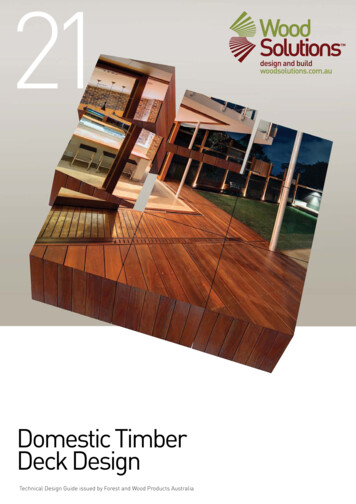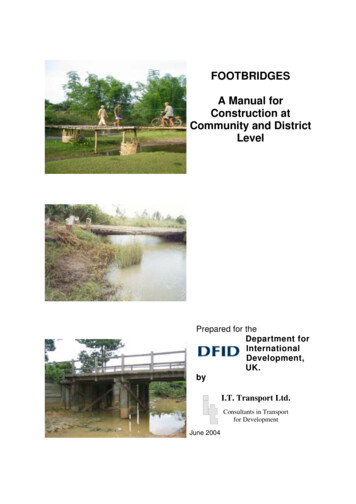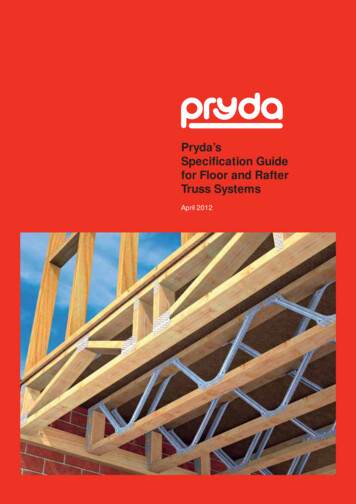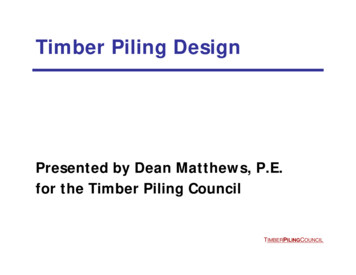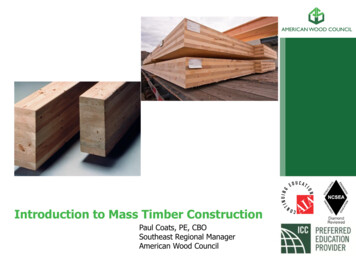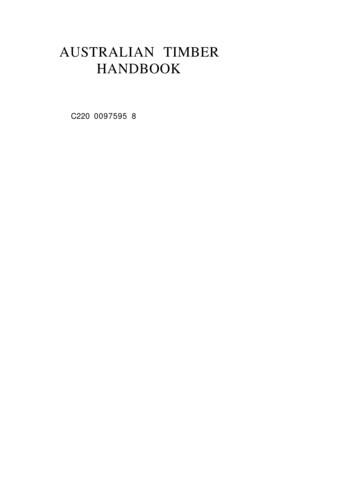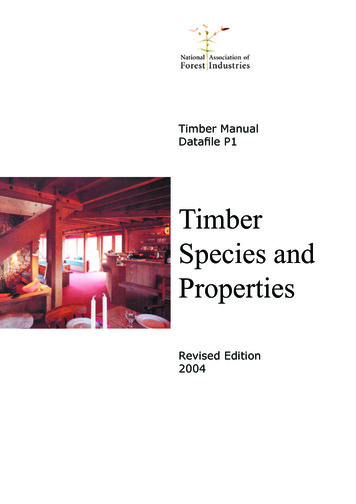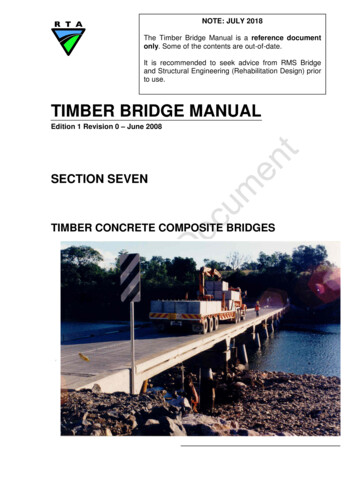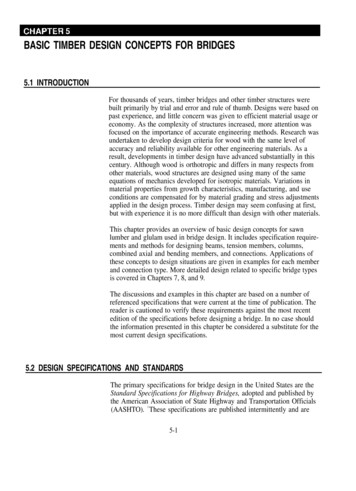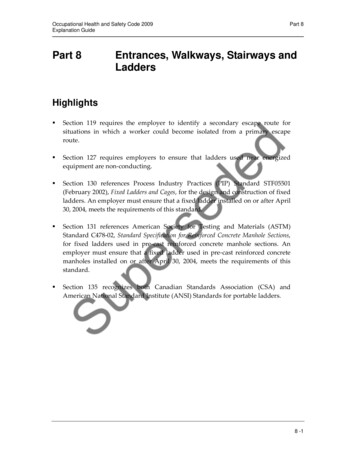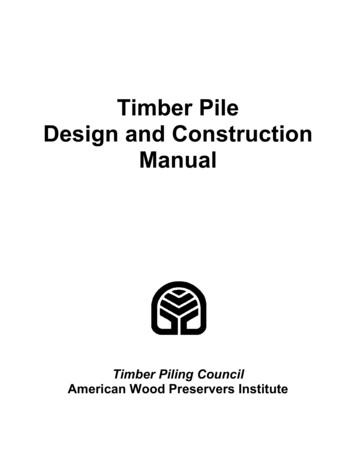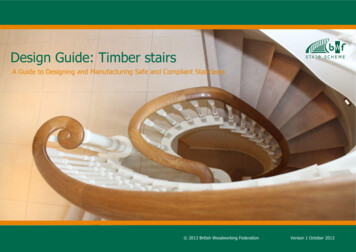
Transcription
Design Guide: Timber stairsA Guide to Designing and Manufacturing Safe and Compliant StaircasesTimber Stair Design Guidewww.bwfstairscheme.org.uk 2013 British Woodworking Federation1 P a g eVersion 1 October 2013
ContentsPageForeword.Section 1.3Introduction.4Section 2Scope and Definitions.5Section 3Performance Requirements.6Section 4Material Selection.8Section 5Loadings.10Section 6Components.11Section 7Layout of a Staircase.17Section 8Demonstrating Performance.25Appendix A Standards applying to staircase performance.29Appendix B NHBC guidance on handrails for winder flights.31.Appendix C Accessing guidance for compliance with the building regulation 2013 British Woodworking Federation32www.bwf.org.ukNote: Whilst every effort has been made to ensure the accuracy of advice given, the BWF cannot accept liability for loss or damage arising from the use ofthe information supplied in this publication.Timber Stair Design Guidewww.bwfstairscheme.org.uk2 P a g e
ForewordThis Design Guidance (Guide) has been prepared by the British Woodworking Federation to provide industry guidance (minimum requirements)for the manufacture of timber stairs for the UK market.In 2004 the British Standards Institution (BSI) declared the standard ‘BS 585 Wood Stairs’ Obsolescent, and since this point there has beenincreased pressure on the staircase market related to a mismatch between UK and EU standards, regulations and codes that have arisen todeal with specific domestic situations.From this environment the BWF Stair Scheme emerged with a focus on effective design and manufacturing principles to support the sector indefining effective design amidst the mêlée of oftentimes conflicting standards and regulations.It’s All in The BadgeThe BWF Stair Scheme is the only accreditation and certification scheme of its kind in the UK. Ranging fromdomestic, common and fire protected common stairs, the standard expected of the manufacturers for theirstairs is high with a drive to improve quality and safety in use, supported by an effective factory productioncontrol system and adherence to the core principles and values laid down in the BWF Code of Conduct.All companies within the scheme are regularly audited to ensure their products and their production meetthese high standards, and the new third-party certification for fire protected common stairs, supported byThe Loss Prevention Certification Board (LPCB) is opening up new markets for timber stairs. The scheme ismanaged by the BWF, and includes manufacturers, as well as approved suppliers, who play an importantpart in maintaining these high standards.Whilst the BWF Stair Scheme does not accredit installation, guidance is available on the installation ofstaircases.Timber Stair Design Guidewww.bwfstairscheme.org.uk3 P a g e
1 IntroductionHow to support Effective Design PrinciplesPrescriptive TablesCalculations to ApprovedMethodsTesting to ApprovedMethodsThis Guide is provided to assist stair designers, manufacturers and building professionals involved in the design and specification of timberstairs for the UK market. It draws information from a plethora of standards and regulations impacting upon staircases. This Guide covers stairspecifications for basic flights, handrails, balusters and other guarding by providing advice on suitable sections, by reference to historical data,design tables, calculation or suitable test methods.Woodworking remains an innovative sector and design will no doubt evolve as new techniques and materials are introduced and more testingand calculations are made available. It is recommended that you check to ensure that you have the latest version of this guide atwww.bwfstairscheme.org.uk.It is important to note that design and manufacture is only part of the delivery of effective staircases, and installation practices must also beadhered to. Whilst the BWF Stair Scheme does not accredit installation, a separate guide focusing on the installation of staircases is alsoavailable from the British Woodworking Federation Stair Scheme to support the installers.Timber Stair Design Guidewww.bwfstairscheme.org.uk4 P a g e
2 ScopeThis Guide covers stairs for private dwellings such as single family dwelling houses orindividual flats or apartments within a building. For imposed loadings this guide refers toEN 1991-1-1:2002 ( UK National Annex) together with the additional guidancepublished in PD6688-1-1:2011 for occupancy type A1. Stair terminology can be found inEN 14076. The Guide draws from the range of standards that impact upon staircases,which are shown in Appendix A.This Guide does not cover Alternating Tread Stairs, or ladders, or the production oftimber stairs for external use or non-domestic applications.Timber stairs can be constructed in a number of different shapes and styles,incorporating a number of non-timber components and can be installed in a variety oflocations. These aspects can have a considerable effect upon the accuracy that can beachieved during production of the stairs and eventually during installation. It is thereforenot the intention of this Guide to provide information on the levels of accuracy that haveto be achieved for any particular finished stair.Fire protection advice of timber stairs, where required, is provided in Section 3‘Performance Requirements’ of this Guide.Stairs sold as complete kits can be CE marked through the EOTA guidance document ETAG 008 (for full title, see Appendix A).Timber Stair Design Guidewww.bwfstairscheme.org.uk5 P a g e
3 Performance Requirements3.1 Standards related to the performance of staircasesThe section covers the key performance criteria for staircases and draws essential information from the relevant standards and regulations.Wherever a conflict exists, the Building Regulations in the appropriate region are deemed to take precedence.3.2 Structural stabilityThe imposed loads to a stair are dynamic and caused by persons moving along the stair. The stairs will need to be either designed to reducethe potential bounce or have sufficient stiffness provided from the fixings, (fixings are covered separately in the BWF Stair Scheme InstallationGuide).The serviceability limit state for a staircase shall be determined in accordance with Section 7 of Eurocode 5.The National Annex to BS EN 1991-1-1 provides loading conditions for various occupancy classes. These indicate vertical loading requirementsfor stairs and landings, as well as horizontal loads to handrails and balustrades.These loadings are identified in Section 5 ‘Loadings’ Tables 5.1 and 5.2.3.3 DurabilityThe usage pattern, and environmental conditions for the stairs which will affect the moisture content of timber and wood-based products, willimpact on durability.Table 3.1 Indicative moisture content values that should be considered for stairsTimber Stair Design GuideLocationMoisture content rangeApproximate relativehumidityInternal use – heated7% to 11%50%Internal use – unheated10% to 14%65%www.bwfstairscheme.org.uk6 P a g e
3.4 Safety in useConsideration of the risk to users should be made to improve the safety in use of stairs. The following aspectsparticularly should be taken into account. Much of this is now covered by following instruction in the BuildingRegulations detailed in Section 7 ‘Layout of a staircase’.3.5 AccessibilityAccessibility is an increasing concern for housing stock and has had significant attention through the evolution inBuilding Regulations and various housing standards in recent times. Layout is critical to this and requiredparameters are set out in Section 7 ‘Layout of a Staircase’.3.6 Fire characteristicsFire characteristics in Building Regulations are made up of two types, ‘Reaction to fire’ and ‘Fire resistance’.3.6.1 Reaction to fireThis characteristic is not required for stairs, particularly in dwellings. It is generally accepted that timber isclassed as a Category E product under BS EN 13501-1 unless given a fire retardant surface coating.3.6.2 Fire resistance – for compartmentationStairs in themselves do not have to provide a fire resistance capability unless they are separating two compartments. For example, if the stairto an upstairs flat is ‘exposed’ to the flat below then a fire resistance capacity will be required. This is usually provided by the fitting of a fireresistant covering to the underside of the stair (plasterboard is the usual choice). If it is necessary to carry out a fire resistance test theappropriate standard to follow is BS EN 1365-6.3.6.3 Certificated fireIt is not normally required for a stair within a single dwelling to require fire protection or to exhibit any limited levels of combustibility.However, where fire performance is required then the staircase will need to be independently certificated by the Scheme’s certification partnerthe Loss Prevention Certification Board (LPCB)Timber Stair Design Guidewww.bwfstairscheme.org.uk7 P a g e
4 Material Selection4.1 GeneralAlthough the mechanical strength of a stair is important, theselection of timber and wood-based products is usuallydetermined by non-structural grading requirements. There isno direct relationship between strength grading rules andjoinery grades, however the tabulated information can bedirectly related to the particular species listed. The informationcontained within the tables in this section should be used toidentify an acceptable minimum non-structural grade level to beused for the various component parts of a stair.Table 4.1 Acceptable species and strength classStrength Classes can be taken from BS EN 1912:2012Structural Timber. Strength classes. Assignment of visual grades and speciesCommon nameBotanical nameStrength classAmerican black walnutJuglans nigraD30American red oakQuercus rubraD40American white oakQuercus albaD50MerantiShorea sppSapeleEntandrophragma cylindricumD40BeechFagus sylvaticaD40American Black CherryPrunus serotinaD30 (guide value)Yellow PoplarLirodendron tulipiferaD40 (guide value)The quality or grade of the timber is important and theparticular grade required to achieve a classification within astrength class is given in BS EN 1912:2012, Structural Timber.Strength classes. Assignment of visual grades and speciesAmerican White AshFraxinus sppD35Caribbean pitch pinePinus caribaeaC27Douglas firPseudotsuga menziesiiC24European larchLarix deciduaC24A list of timber species commonly used for staircases is given inTable 4.1. This list should not be considered exhaustive, but ifa species is not on the list, manufacturers should checkproperties of species or grade chosen to ensure thatperformance has been proven through calculation or test.European oakQuercus roburC24European redwoodPinus silvestrisC24European whitewoodPicea abiesC24HemlockTsuga heterophyllaC24Parana pineAraucaria angustifoliaC24Radiata PinePinus radiataC24Southern yellow pinePinus palustrisC244.2 TimberTimber Stair Design Guidewww.bwfstairscheme.org.ukvariable8 P a g e
4.3 Wood-based componentsWood-based panels can be used in stair components.Table 4.2 Indicates the minimum specification for two environmental situations.Board typeInternal heatedInternal unheatedPlywoodBS EN 636-1, 2, 3BS EN 636-2, or 3Particle boardBS EN 312-4BS EN 312-5Oriented strand boardBS EN 300 (Type OSB/2)BS EN 300 (Type OSB/3)FibreboardsBS EN 622-2 (Type HB.LA)BS EN 622-2 (Type HB.LA1)4.4 AdhesivesAdhesives should be selected as appropriate for the environment. The minimum performance level for internal adhesives should be at leastClass D3 from BS EN 204 or Class C1 of BS EN 12765.4.5 Non-timber materials4.5.1 GlassGlass is often used to form treads, risers and balustrades. This Guide does not provide information on the use of glass in these situations.Advice can be sought from the BWF Technical Department.4.5.2 MetalsMetals are often used to connect components together and to form components in place of timber. Components that provide structuralstrength such as screws, nails and bolts, should be selected and designed in accordance with Eurocode 5. Metals used to provide componentssuch as balustrades or stair strings are not covered by this Guide and reference should be made to a competent person with structuralengineering knowledge of the metal. Any metal component used in a stair designed to this Guide should be capable of achieving theTimber Stair Design Guidewww.bwfstairscheme.org.uk9 P a g e
appropriate corrosion resistance when subject to the neutral salt spray test specified in BS EN 1670. The minimum class should be Class 2 forall heated environments and Class 3 for all unheated environments. Some species of timber contain extractives that can interact with metals;care should be taken to ensure that adequate protection is provided against corrosion.5 LoadingsFor imposed loadings this guide refers to EN1991-1-1:2002 ( UK National Annex) together with the additional guidance published in PD66881-1:2011 for occupancy type A1.Loads for determining performance are provided in Tables 5.1 and 5.2. Note when using these tables, the point load is applied at the positionthat gives the most onerous requirement. Where individual balusters are used each should be capable of resisting half the concentrated load.Total displacement of a handrail should not exceed 25 mm. If this is not achievable, the handrail should be capable of withstanding 2.5 timesthe applied load during single test, without failure.Table 5.1 Loading to strings, treads and landingsOccupancy class A1Uniformly Distributed Load (UDL)(UK NA Table NA3) qk (kN/m2)1.5Concentrated load (UK NA TableNA3) Qk (kN)2.0Table 5.2 Horizontal loads to handrails and balustradesHorizontal UDL to handrail(UK NA Table NA8) qk (kN/m)Occupancy class A1Timber Stair Design Guide0.36Horizontal UDL applied to infill(PD 6688-1-1 Table 2)(kN/m²)0.5www.bwfstairscheme.org.ukHorizontal concentrated load(PD 6688-1-1 Table 2)(kN)0.3510 P a g e
6 ComponentsThis section looks at component dimensions andrecommended jointing methods. Information is forguidance only. Workmanship should generally complywith BS 1186-2. Where component sizes can’t bedetermined by prescriptive data calculations and testingoptions are defined in Section 8.6.1. Component dimensionsTable 6.1 gives prescriptive minimum sizes of acomponent for a standard stair (in accordance with oneor more of the relevant assessment standards listed inAppendix). The component sizes assume a maximum900 mm overall stair width, with 13 full risers and treadslet into strings.Table 6.2 gives further prescriptive minimum dimensionsfor stair treads, with and without risers, calculated fordifferent strength classes of timber.Table 6.1 Prescriptive dimensions for staircase componentsComponentPrescriptive design sizes (mm)Strings220 x 26Treads2018 plywood22 MDFRisers99 plywood9 MDFWinder2018 plywood22 MDFNewel82 x 82Handrail68 x 45Balusters to stair (900 mm27 square or 35 turned at narrowesthigh) & landings in domesticdimensionuseWhere a combination is not represented by these tables, calculation or testing to demonstrate performance should be conducted as per therequirements in Section 8 ‘Demonstrating Performance’, (note: loads used during tests are subject to factors to account for the specificduration of the tests).Timber Stair Design Guidewww.bwfstairscheme.org.uk11 P a g e
Table 6.2 Tread thickness for Occupancy Class A1 stairsGradeC24 )24Fm,k(N/mm2)27Length of treadstring to string(mm)170 mmww/oriser riserDepth of Tread (nosing to back edge of tread) mm200 mm225 mm250 mm275 mmww/oww/oww/oww/oriser riser riser riser riser riser riser riser300 mmww/oriser gth of treadstring to string(mm)170 mmww/oriser riserDepth of Tread (nosing to back edge of tread) mm200 mm225 mm250 mm275 mmww/oww/oww/oww/oriser riser riser riser riser riser riser riser300 mmww/oriser e: For the purposes of this table “w” means with and “w/o” means withoutTimber Stair Design Guidewww.bwfstairscheme.org.uk12 P a g e
Table 6.2 Tread thickness for Occupancy Class A1 stairs N/mm2)40Fm,k(N/mm2)Length of treadstring to string(mm)1400050300 mmww/oriser gth of treadstring to string(mm)600D50170 mmww/oriser riserDepth of Tread (nosing to back edge of tread) mm200 mm225 mm250 mm275 mmww/oww/oww/oww/oriser riser riser riser riser riser riser riser170 mmww/oriser riser1831Depth of Tread (nosing to back edge of tread) mm200 mm225 mm250 mm275 mmww/oww/oww/oww/oriser riser riser riser riser riser riser riser1830182918281827300 mmww/oriser 324931473045294428422741Note: For the purposes of this table “w” means with and “w/o” means withoutTimber Stair Design Guidewww.bwfstairscheme.org.uk13 P a g e
Table 6.2 Tread thickness for Occupancy Class A1 stairs h of treadstring to string(mm)170 mmww/oriser riserDepth of Tread (nosing to back edge of tread) mm200 mm225 mm250 mm275 mmww/oww/oww/oww/oriser riser riser riser riser riser riser riser300 mmww/oriser e: For the purposes of this table “w” means with and “w/o” means withoutThe design sizes tabulated are calculated using EN 1995-1-1 (Eurocode 5) assuming the tread is a simply supported beam subjected to theloads given in Table 5.1.Reduced tread sizes may be achieved by carrying out a more rigorous structural analysis stairwell as a system.Timber Stair Design Guidewww.bwfstairscheme.org.uk14 P a g e
6.2 Design of componentsFigure 6.1The following clauses give guidance on the joints within a stair. In theabsence of test evidence or calculation, these recommendations should beconsidered as a minimum.6.2.1 TreadsTimber members of more than one piece should be jointed as specified inBS 1186-2.6.2.2 RisersRisers should be fixed to the edge of the lower tread with No.10 gaugescrews at centres not exceeding 230 mm. Penetration should be not lessthan 23 mm or 1.5 times the riser thickness.The top of each riser should be located into a groove in the underside ofthe tread with a minimum depth of 5mm up to a maximum depth of aquarter of the tread thickness. This joint should be further supported byangle blocks 75 mm long and 38 mm width on the shorter edges, glued tothe riser and tread. The number of blocks will vary according to the widthof the stair.Width up to 900 mm, 2 blocksWidth between 900 mm and 990 mm, 3 blocksWidth between 990 mm and 1200 mm (and tapered treads over 1200 long), 4 blocks6.2.3 StringsStrings should be housed to receive the treads and risers to a depth of 12 mm or 0.4 times the string thickness, whichever is the greater. Thishousings should be tapered to receive wedges to support the tread and riser. The wedges should be fitted with adhesive to form a rigid joint.Where the aesthetics demand, wedges may be omitted, but an alternative side restraint system will be needed.Timber Stair Design Guidewww.bwfstairscheme.org.uk15 P a g e
Where strings are fitted into newels, the ends of the strings should have tenons formed to fit into thenewels. The tenons should be not less than 12 mm thick and not less than 45 mm long. However, wheretwo strings are joined to a newel one or both tenons may be reduced in length or haunched to allowboth tenons to be accommodated.For winder stairs, the upper and lower strings may need to be enlarged to accommodate the housings ofthe winders where the stair turn occurs.Where a stair is to be supported on timber carriages the design and fabrication should be checked by aperson qualified in structural detailing.6.2.4 NewelsNewels should be housed not less than 12 mm deep receive the ends of the treads and risers and shouldbe morticed for strings and handrails as required.6.2.5 Handrails and balustradesHandrails and balustrades should be designed in accordance with BS 5395-1. Stairs with a rise of over600 mm should have a handrail. Where the stair width exceeds 1000 mm a handrail should be fitted onboth sides. On winder flights the handrail should be fitted on the wider side of the stair, see also NHBCguidance document.Individual lengths of handrail to a stair flight should be capable of being held continuously without interruption from any fixing or support.Stairs in non-domestic situations should be fitted with a handrail which commences at least 300 mm before the first tread and is continuous atleast 300 mm beyond the last upper nosing of the flight. Elliptical handrails may be a maximum of 50 mm wide to the upper surface. Forfurther details see Section 7 ‘Layout of a staircase’ Clause 7.5.6.3 Demountable componentsIn order to facilitate the movement of furniture it may be necessary to construct stairs with demountable handrails and newels. Thesecomponents must still be designed to the same criteria as fixed components.Timber Stair Design Guidewww.bwfstairscheme.org.uk16 P a g e
7 Layout of a StaircaseThe following section summarises regional guidance given forcompliance with the Building Regulations. The full guidancedocuments are listed in Appendix C.Note: maximum R and minimum G cannot be used together as thiswould result in a pitch greater than 42⁰.Treads cannot have a breadth (measured from the nosing to theback edge of the tread) less than the going. (i.e. consecutive treadsmust overlap)Regulations in England state that:R 150 mm - 220 mm and G 220 mm - 300 mmRegulations in Wales state that:R 155 mm to 220 mm and G 245 mm to 260 mmorR 165 mm to 200 mm and G 223 mm to 300 mmorMaximum R 220 mm and Minimum G 220 mm following also themaximum pitch and the limits of 2R G.7.1 Steepness of stairs– Rise (R) and Going (G)The requirements for the steepness of stairs can alternatively bemet by following the recommendations of BS 5395-1:1977.Diagram ARegulations in Scotland state that:From AD K 2013 page 4 diagram 1.1 – Measuring rise and going –DwellingsIn all locationsR 100 mm to 220 mm and G 225 mm or greaterRegulations in Northern Ireland state that:R 100 mm to 220 mm and G 225 mm or greaterThe maximum pitch of a stair is 42⁰.The normal relationship between the dimensions of rise (R) andgoing (G) is: 550 mm (2R G) 700 mm.Timber Stair Design Guidewww.bwfstairscheme.org.uk17 P a g e
7.2 Headroom for stairsFor standard stairs England, Northern Ireland, Scotland andWalesThe minimum headroom must be 2 m as shown in Diagram B below.For loft conversions in England, Northern Ireland, Scotlandand WalesWhere there is not enough space to give 2 m headroom as shown inDiagram B, reduced headroom would be permitted as shown inDiagram C below.Diagram BDiagram CFrom AD K 2013 page 7 diagram 1.3 – Minimum headroom – DwellingsFrom AD K 2013 page 8 diagram 1.4 – Reduced headroom for loftconversions – DwellingsTimber Stair Design Guidewww.bwfstairscheme.org.uk18 P a g e
7.3 Width of flights of stairsRegulations in England, Northern Ireland and Wales state that:Where a stepped change in level within the entrance storey of a dwelling isunavoidable, e.g. on severely sloping plots, the minimum stair width is 900 mmRegulations in Scotland state that:The clear or effective width of a stair should allow users to move up and downunhindered and permit people to pass on a flight.The effective width should be measured between handrails or, where there is nohandrail present, between any walls or protective barriers, see Diagram D.The effective width of a private stair shall be:900 mm where the stair passes between one storey and another or connects levelswithin a storey.Diagram DFrom DFPNI Technical Booklet H 2012 page 25 diagram 3.4 –Measuring the width of a private stair and a common stair in ablock of dwellings.Timber Stair Design Guide600 mm where the stair serves only sanitary accommodation and/or one roomother than accessible sanitary accommodation, a kitchen or an enhancedapartment.800 mm where a continuous handrail is fitted to both sides of the flight.www.bwfstairscheme.org.uk19 P a g e
7.4 Length of flights of stairsRegulations in England, Northern Ireland and Wales state that:Where a stair has more than 36 risers in consecutive flights there must be a leastone change in direction between flights, see Diagram E.Stairs in dwellings can have a single step and there is no limit on the number ofrisers between landings.Diagram EFrom AD K 2013 page 9 diagram 1.6 – Change in directionbetween flights – DwellingsRegulations in Scotland state that:Generally, a flight should have not more than 16 rises and not less than 3 rises.There may be less than 3 rises; within an apartment (excluding an enhancedapartment); within sanitary accommodation (other than accessible sanitaryaccommodation); between a landing and an adjoining level where the route oftravel from the adjoining level to the next flight changes direction through 90⁰.7.5 Handrails for stairsRegulations in England state that: Position the top of the handrail between 900 mm and 1100 mm from the pitch line or floorThe handrail may form the top of the guarding if the heights can be matched. Handrails are required on both sides of stairs 1000 mm wide orwider. Where a stepped change in level within the entrance storey of a dwelling is unavoidable, for example on severely sloping plots, if aflight consists of three or more risers, a suitable continuous handrail is required on each side of the flight and any intermediate landings.Regulations in Wales state that: Stairs should have a handrail on at least one side if they are less than 1m wide and a handrail on bothsides if they are wider. Handrails should be between 900 mm and 1000 mm measured to the top of the handrail from the pitch line or floorRegulations in Scotland state that: Position the top of the handrail between 840 mm and 1000 mm from the pitch line or floor.A handrail need only be provided to one side on a flight of a private stair, however, the side on which the handrail is not fixed should permitthe installation of a second handrail at a future date provided a clear width of 800 mm is maintained. For a private stair the handrail shouldhave a profile and projection that will allow a firm grip.Timber Stair Design Guidewww.bwfstairscheme.org.uk20 P a g e
Regulations in Northern Ireland state that: Where the circulation route within the entrance storey or the access to the circulation routewithin the principal storey includes a stair, the stair shall have a suitable continuous handrail on each side of the flight and any intermediatelanding.Flights in a private stair with a total rise of more than 600 mm should have a continuous handrail that gives firm support and a firm grip and belocated:(a) on at least one side where the stair is less than 1000 mm wide; or(b) on both sides where the stair is 1000 mm wide or more.Where only one handrail is required on a flight with tapered treads, it should be located on the outer side of the flight. Handrails are notrequired beside the two steps at the bottom of a private stair. Handrails should be at a height between 900 mm and 1000 mm measuredvertically above the pitch line. Handrails may form the top of guarding.7.6 WindersRegulations in England and Northern Ireland state that: The rise and goingmust conform to the limits given above for straight flights. Consecutive tapered treadsmust have the same going, but if a stair consists of straight and tapered treads thenthe going of the tapered treads must not be less than the going of the straight treads,see Diagrams F and G.Regulations in Wales state that: Stairs designed to BS 585-1:1989 will offerreasonable safety.Regulations in Scotland state that: A flight consisting wholly of tapered treadsshould be constructed in accordance with BS 5395-2:1984 but the provisions of thetechnical guidance should be taken into account.Diagram FFrom AD K 2013 page 12 diagram 1.9 – Measuringtapered treads – Winder flightTimber Stair Design Guidewww.bwfstairscheme.org.uk21 P a g e
Supplementary information for winders:The following information supplements the guidance given above for the relevantBuilding Regulations for winders:1.2.3.4.5.6.7.Diagram GFrom AD K 2013 page 12 diagram 1.9 – Measuring taperedtreads – Helical Stairs8.The clear width of the flight is measured between stringsThe maximum clear width for a winder flight is 1000 mmThe walk line approaching (or leaving) a winder is taken from the centreline of the clear width of the narrowest straight flights above or below thewinder flight.The maximum change in direction through the winder flight is 180⁰The width of any tapered treads at their narrowest part must be 50 mm ormore - measured nosing to nosing, i.e. measurement from nosing to risermust be 50 mm plus the projection of the nosing.The walk-line through the winder flight will follow the arc of the circle,centred on the newel post (or the intersection of strings where there is nonewel post) and tangent to the centre line of the clear width of thenarrowest straight flights above or below the winder flight.The going shall be measured from the intersection of this arc with theno
Timber Stair Design Guide www.bwfstairscheme.org.uk 8 P a g e 4 Material Selection 4.1 General Although the mechanical strength of a stair is important, the selection of timber and wood-based products is usually determined by non-structural grading requirements. There is no d
